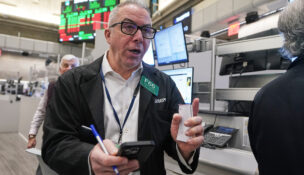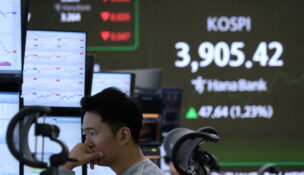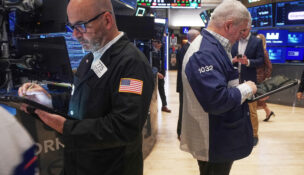US stocks dip as tariffs and oil prices shake markets
Manufacturing updates cause market drift

Traders William Lawrence, left, and Mark Mueller work on the floor of the New York Stock Exchange, Thursday, May 29, 2025. (AP Photo/Richard Drew)

Traders William Lawrence, left, and Mark Mueller work on the floor of the New York Stock Exchange, Thursday, May 29, 2025. (AP Photo/Richard Drew)
US stocks dip as tariffs and oil prices shake markets
Manufacturing updates cause market drift
SUMMARY:
- US stocks dip amid steel tariff concerns
- Dow drops 218 points, S&P 500 down 0.1%
- Automakers down, steel stocks up as oil prices jump
- Treasury yields rise in bond market reaction
NEW YORK (AP) — U.S. stocks are drifting on Monday following some discouraging updates on U.S. manufacturing, the area of the economy that President Donald Trump is trying to revive through his trade war and tariffs.
The S&P 500 was 0.1% lower in afternoon trading. The Dow Jones Industrial Average was down 218 points, or 0.5%, as of 12:41 p.m. Eastern time, and the Nasdaq composite rose 0.2%.
Stocks dipped after a report from the Institute for Supply Management said U.S. manufacturing activity shrank by more last month than economists expected. Trump has been warning that U.S. businesses and households could feel some pain as he tries to use tariffs to bring more manufacturing jobs back to the country, but their on-and-off rollout has created lots of uncertainty.
“The impact of ever-changing trade policies of the current administration has wreaked havoc on suppliers’ ability to react and remain profitable,” one company in the transportation equipment industry said in the ISM’s survey.
Another in the computer and electronics products industry said, “Government spending cuts or delays, as well as tariffs, are raising hell with businesses. No one is willing to take on inventory risk.”
A separate report from S&P Global on manufacturing came in better than expected, but the overall figure “masks worrying developments under the hood of the U.S. manufacturing economy,” said Chris Williamson, chief business economist at S&P Global Market Intelligence. He said uncertainty caused by tariffs has worries high about supplier delays and rising prices.
Monday’s moves also came after more harsh rhetoric crossed between the world’s two largest economies, just a few weeks after the United States and China had agreed to pause many of their tariffs that had threatened to drag the economy into a recession.
China blasted the United States on Monday for moves that it said hurt China’s interests, including issuing AI chip export control guidelines, stopping the sale of chip design software to China and planning to revoke Chinese student visas.
“These practices seriously violate the consensus” reached during trade discussions in Geneva last month, the Commerce Ministry said in a statement. That followed President Donald Trump’s accusation at the end of last week, where he said China was not living up to its end of the agreement that paused their tariffs against each other.
Hopes for lower tariffs because of trade deals that Trump could reach with other countries were the main reasons for a big rally on Wall Street last month, which brought the S&P 500 back within 3.8% of its all-time high. The index had dropped roughly 20% below the mark in April.
But Trump on Friday told Pennsylvania steelworkers he’s doubling the tariff on steel imports to 50% to protect their industry, a dramatic increase that could further push up prices for a metal used to make housing, autos and other goods.
Later in a post on his Truth Social platform, Trump confirmed the steel tariff and said that aluminum tariffs would also be doubled to 50%. Both tariff hikes would go into effect Wednesday, Trump said.
That helped stocks of U.S. steelmakers climb. Nucor jumped 8.3%, and Steel Dynamics rallied 9.3%.
But automakers and other heavy users of metals weakened. General Motors reversed by 4.6%, and Ford fell 4.4%.
Lyra Therapeutics soared 409.3% after reporting positive late-stage trial results of an implant to treat chronic sinus inflammation in some patients.
Some of Monday’s strongest action was in the oil market, where the price of crude climbed roughly 4%. The countries in the OPEC+ alliance decided to increase their production again, a move that often pushes crude prices down because it puts more on the market, but analysts said investors were widely expecting it. The past weekend’s attacks by Ukraine in Russia also helped to raise uncertainty about the flow of oil and gas around the world.
A barrel of U.S. crude rose 3.9% to $63.19, while Brent crude, the international standard, gained 3.8% to $65.15.
In stock markets abroad, Hong Kong’s Hang Seng fell 0.6% following the harsh words tossed between the United States and China. A report over the weekend also said that China’s factory activity contracted in May, although the decline slowed from April.
Indexes also dipped across much of the rest of Asia and Europe. Japan’s Nikkei 225 was one of the biggest movers after falling 1.3%.
In the bond market, Treasury yields rose as worries continue about how much debt the U.S. government will pile on due to plans to cut taxes and increase the deficit.
The yield on the 10-year Treasury rose to 4.46% from 4.41% late Friday and from just 4.01% roughly two months ago. That’s a notable move for the bond market.
Besides making it more expensive for U.S. households and businesses to borrow money, such increases in Treasury yields can deter investors from paying high prices for stocks and other investments.
l
















